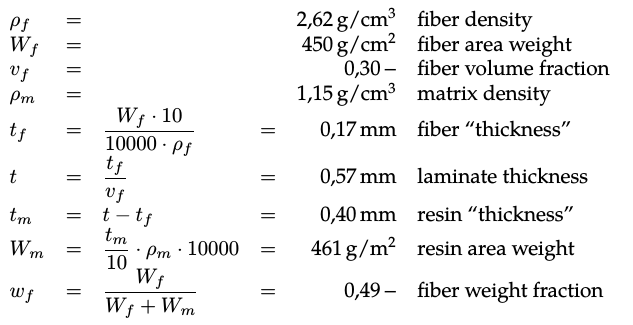TeXcalc
As an engineer, I often do diverse calculations that I want to save in my
logbooks which I write in LaTeX.
Up to now I’ve either formatted those by hand or used the listings package
to include calculations made in IPython.
These techniques are not optimal. Formatting by hand makes it time consuming and error-prone to change the typeset calculations; results have to be changed by hand. Using the listings package works, but this can only contain the calculations without explanations or units, and the results aren’t always nicely formatted
Technical calculations without units are generally meaningless, so it was important for me to be able to include them in the results.
So I wrote a Python module called texcalc that allows me to do
calculations and typesets the results for me. It works like this;
from __future__ import print_function
from texcalc import Calculation
c = Calculation()
c.add('rho_f', 2.62, 'g/cm^3', 'fiber density')
c.add('W_f', 450, 'g/cm^2', 'fiber area weight', fmt='.0f')
c.add('v_f', 0.3, '-', 'fiber volume fraction')
c.add('rho_m', 1.15, 'g/cm^3', 'matrix density')
c.add('t_f', 'W_f*10/(10000*rho_f)', 'mm', 'fiber “thickness”')
c.add('t', 't_f/v_f', 'mm', 'laminate thickness')
c.add('t_m', 't-t_f', 'mm', 'resin “thickness”')
c.add('W_m', 't_m/10*rho_m*10000', 'g/m^2', 'resin area weight', fmt='.0f')
c.add('w_f', 'W_f/(W_f+W_m)', '-', 'fiber weight fraction')
print(c)
Using a Calculation object one can define a sequence of variable
assignments or expressions using variables that have been assigned earlier.
Printing the Calculation (or rather converting it to a string) will cause
a LaTeX formatted version in the form of an array environment to be produced.
When this is written to a file it can be included in a LaTeX document using
\input.
The typeset result looks quite nice. (Note that siunitx was set up to use a
decimal comma in this example);

It uses the siunitx package to typeset the units of the variables and
calculation results.
It uses \mbox to include plain text in the otherwise math-mode
environment.
This means that the comments should be kept reasonably short so they fit one
one line.
The generated LaTeX code isn’t set up to handle comments that would span
multiple lines.
$\begin{array}{lclcrl}
\rho_f & = & & & \mbox{\SI{2.62}{g/cm^3}} & \mbox{fiber density} \\
W_f & = & & & \mbox{\SI{450}{g/cm^2}} & \mbox{fiber area weight} \\
v_f & = & & & \mbox{\SI{0.30}{-}} & \mbox{fiber volume fraction} \\
\rho_m & = & & & \mbox{\SI{1.15}{g/cm^3}} & \mbox{matrix density} \\
t_f & = & \displaystyle \frac{W_f\cdot 10}{10000\cdot \rho_f} & = & \mbox{\SI{0.17}{mm}} & \mbox{fiber “thickness”} \\
t & = & \displaystyle \frac{t_f}{v_f} & = & \mbox{\SI{0.57}{mm}} & \mbox{laminate thickness} \\
t_m & = & \displaystyle t-t_f & = & \mbox{\SI{0.40}{mm}} & \mbox{resin “thickness”} \\
W_m & = & \displaystyle \frac{t_m}{10}\cdot \rho_m\cdot 10000 & = & \mbox{\SI{461}{g/m^2}} & \mbox{resin area weight} \\
w_f & = & \displaystyle \frac{W_f}{W_f+W_m} & = & \mbox{\SI{0.49}{-}} & \mbox{fiber weight fraction} \\
\end{array}$\hfill
Note
This module uses eval, which exposes the full capabilities of the
Python interpreter. This module should therefore _not_ be used with
untrusted input!
The source repository is now available on github. This program is now written
for Python 3. The generated LaTeX code requires the siunitx package.
For comments, please send me an e-mail.
Related articles
- img4latex
- Formatting git changelogs for LaTeX
- Profiling Python scripts(6): auto-orient
- Profiling with pyinstrument
- From python script to executable with cython